Menu
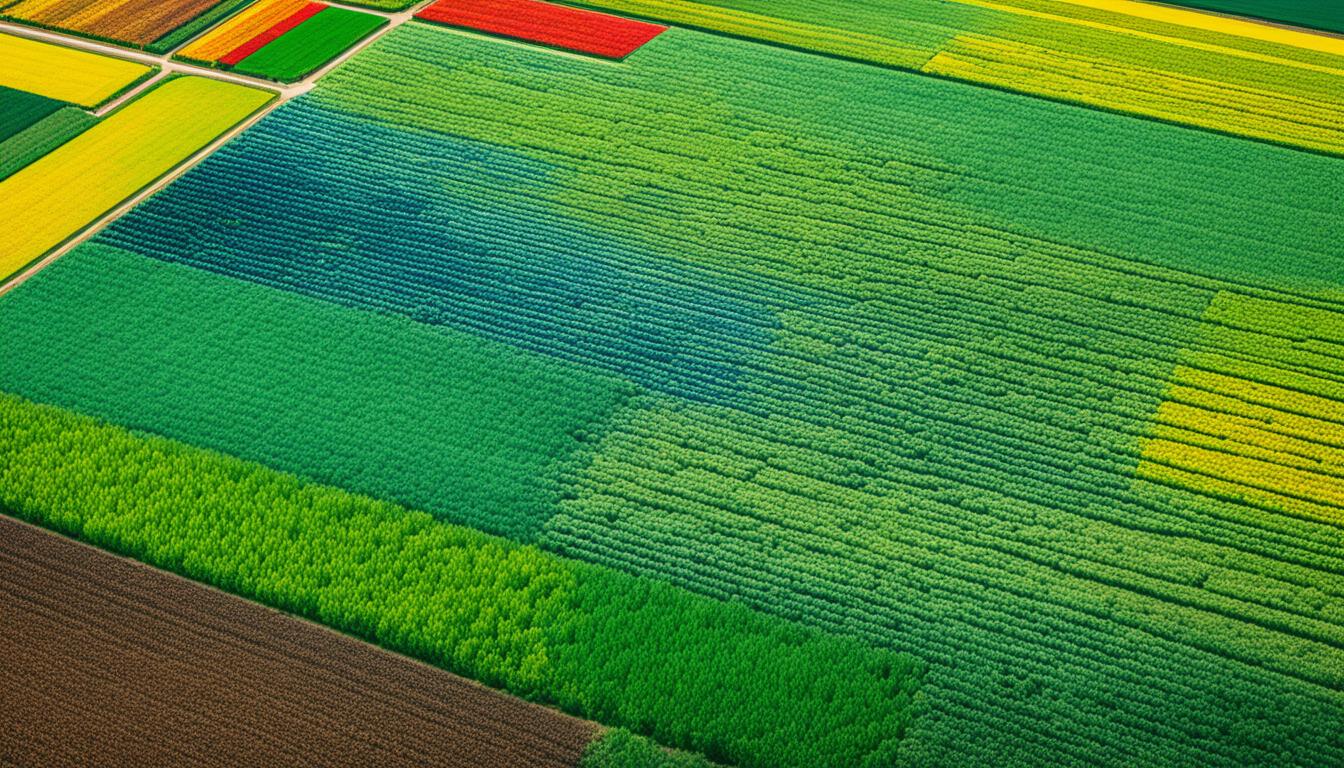
Did you know that with precision farming, crop yields can go up by 30%? It can also save up to 40% of the water we use. In California’s Central Valley, these methods have made a big difference. This shows how powerful precision agriculture analytics can be. Through my work as a journalist, I’ve heard many great stories. One of the most inspiring is Sarah’s. She used machine learning in her farm and saw amazing results. Sarah’s story highlights how technology and creativity can work together effectively.
The use of agricultural technology solutions like sensors, drones, and AI is changing farming. Farmers can now make smart decisions quickly. This helps from planting to harvest, making farming more efficient and kind to the environment. This use of farm data analysis is a big part of precision agriculture. It means looking at all the data to improve crops. This is key to making sure we can feed more people each year.
Precision agriculture mixes farming with technology to make farming more efficient, sustainable, and profitable. It uses smart farming data to monitor everything from soil moisture to nutrient levels. This approach aims to boost productivity and quality by using the right amount of water and fertiliser.
The heart of precision agriculture is managing different factors like soil, plant health, and the effects of pesticides. Tools help with detailed data analysis. For example, grid soil sampling and data from remote sensors show the health of crops and stress on plants.
Crop scouting during the season makes decisions better by spotting weed patches and areas with erosion. Geographic Information Systems (GIS) gather detailed information like yield and soil maps. This data, along with crop management software, helps farmers in their planning.
Corrected GPS signals can be accurate within 3 to 10 feet, a big improvement over uncorrected signals. The Coast Guard provides free GPS correction in Missouri. This service, along with help from satellites and drones, allows for very accurate estimates on soil and crop conditions.
The big aim of precision agriculture is to use every acre wisely. It does this through smart analysis and decision-making, aiming for a future of farming that supports the environment.
In modern agriculture, machine learning is key. It’s transforming how we farm using new technologies. These tools allow farmers to work smarter, not harder.
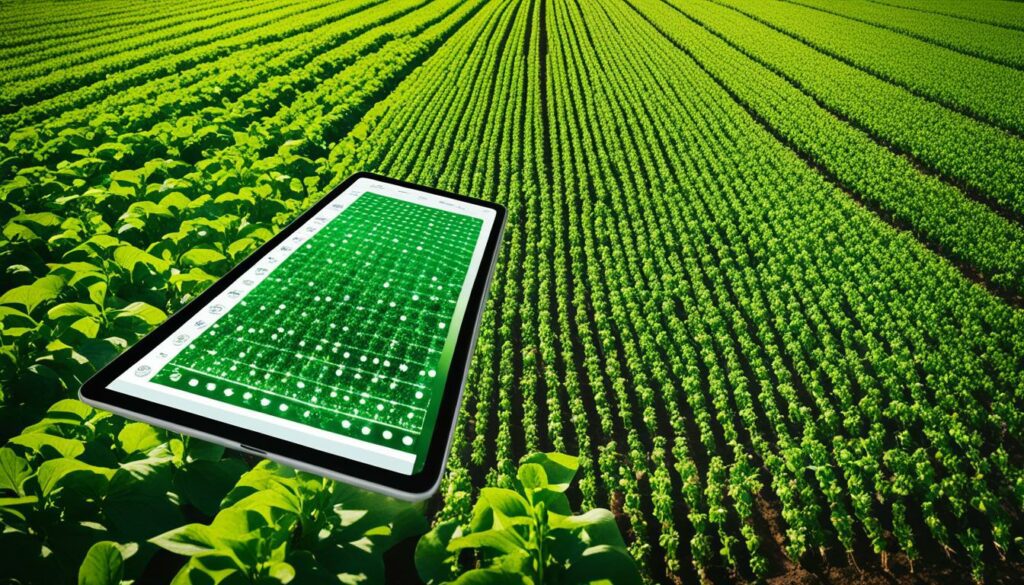
Machine learning in agriculture has introduced advanced ways to monitor crops. It uses data from various sources to check crop health. This means farmers can see how their crops are doing in real-time.
This tech helps farmers make better decisions, boosting their harvests. All choices are based on solid data, thanks to agritech insights. This leads to higher quality and more crops.
Merging machine learning in agriculture helps spot and stop diseases early. Drones with special sensors can find signs of trouble. They pick up pest infestations or nutrient issues fast.
This early warning system can save crops from harm. It cuts down on the need for harmful chemicals. An Indian start-up even made an app for spotting crop diseases. It helps farmers act before it’s too late.
Machine learning in agriculture changes resource use for the better. Farmers can now carefully manage soil and weather. This saves water and reduces fertiliser use.
Thanks to AI, planting and watering times are just right. This leads to healthier crops. In California, using this tech increased grape output. It’s all about doing more with less.
Bringing precision agriculture analytics into farming will make our harvests better. More tech means even more improvements. We can look forward to better disease forecasts, smarter pest control, and more robots helping on the farm.
The main goal of precision agriculture analytics is to increase crop yields. It does this by using less resources and reducing environmental harm. Using agritech insights, farmers analyse big data with the help of machine learning. This helps them make quick decisions, crucial for boosting crop yield.
In precision agriculture, data is collected using modern sensors, drones, and more. They gather info on soil, weather, and crop health. Farmers can then decide on planting, water use, and fertiliser. This process not only increases yield but also helps meet sustainability targets.
Farm work like planting and watering is now done with great precision. Satellites and drones take photos to check crop health and find diseases. Soil sensors give up-to-the-minute moisture, nutrient, and pH levels. This fine-tunes water and fertiliser use.
Using smart farming data with GPS makes field mapping more accurate. Variable Rate Technology (VRT) applies inputs like seeds and fertilisers wisely, following the data’s advice.
The Internet of Things (IoT) helps by collecting field data for quick analysis in the cloud. This speeds up decision-making, leading to better yields and more sustainable farming.
Various technologies help reach these aims:
| Technology | Function |
|---|---|
| Soil Sensors | Real-time data on moisture, nutrient content, and pH levels |
| Drones | High-resolution imagery for monitoring crop health |
| GPS Technology | Precise field mapping and machinery tracking |
| Variable Rate Technology (VRT) | Efficient input application based on data insights |
| Internet of Things (IoT) | Real-time data collection and cloud analysis |
By using these high-tech tools, farmers can get the most out of their work. Precision agriculture analytics leads to smart farming. It’s changing agriculture, making it more efficient and productive.
Modern farming relies on data to make decisions. Farmers analyse data from sensors, satellites, and drones to improve their crops. This approach is powered by technology, allowing for better decisions based on a farm’s environment.
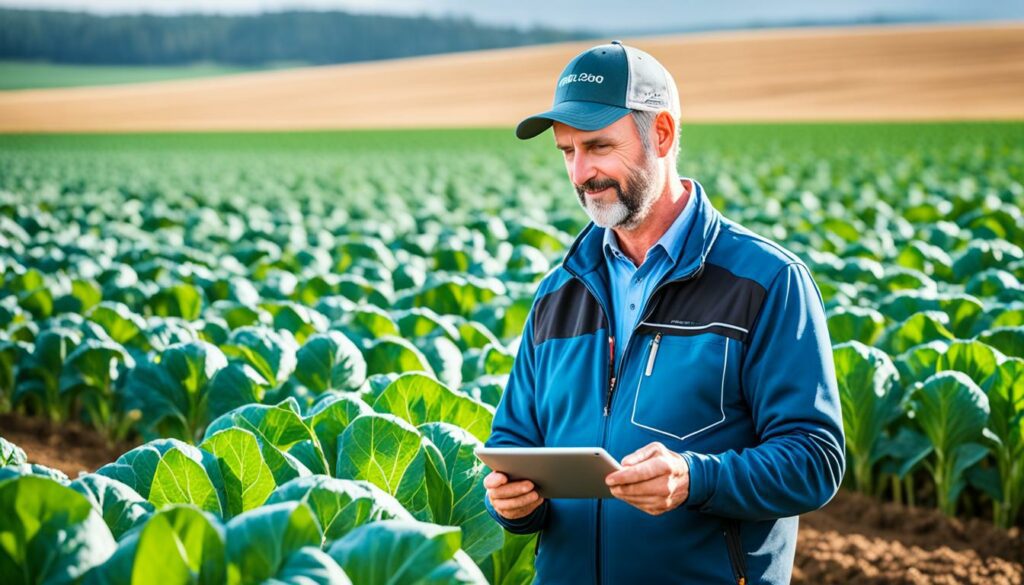
A key use of technology on farms is checking soil moisture through sensors. This helps with efficient water use. Satellites give detailed crop information, offering specific solutions for better growth. These methods reduce waste and improve how farms work.
Access to data tools and know-how can be a challenge for farmers. Bridging this gap is crucial. Companies like IBM are teaching farmers how to use data effectively. This training helps them make the best decisions.
Data on weather, soil, and crops is vital for smart farming. New sensor technology allows constant monitoring of farm conditions. Drones and satellite photos show detailed farm maps. This aids in making accurate and timely decisions for the farm.
When using technology on farms, data privacy is key. It’s important to handle data safely and fairly. With care, farms can be more efficient and better prepared for the future. This leads to a sustainable and profitable agriculture industry.
Field monitoring tools are key in modern agriculture. They help farmers manage their crops better. With these tools, farmers understand their fields in detail. This leads to using resources in the best way.
This technology includes sensors and remote data analysis. Farmers can now work more efficiently with the help of these tools. They get detailed insights that were not available before.
Sensor-based technology is changing how farming works. These sensors look at things like soil moisture and nutrient levels. They provide data that helps farmers make smart choices, boosting their harvests.
Firms like Taranis use the latest in AI to suggest what farmers should do. This advanced tech is becoming crucial for farmers worldwide.
Looking at data from far off is also important for farmers. By using satellite pictures and drone videos, they see their fields in a new light. This helps with spotting problems early, like diseases in crops.
The John Deere Operations Center™ leads the way in this kind of technology. It gives farmers a place to check their information any time. This quick access to data makes decision-making faster and more precise.
| Metric | Taranis | John Deere |
|---|---|---|
| Acres Processed | 0 | N/A |
| Created Fields | 0 | N/A |
| Registered Users | 0 | N/A |
| Counted Plants | 0 | N/A |
When all these field monitoring tools come together, farmers do better. They get accurate measurements and deep insights. This helps them look after their crops in a sustainable way.
Artificial intelligence and computer vision are changing how we farm today. They allow for very precise crop management. This leads to better crops and saves resources. Companies like Taranis use AI to analyse crop images from above. They then suggest the best ways to water and feed crops. This high-tech help makes sure farmers know exactly what each plant needs.
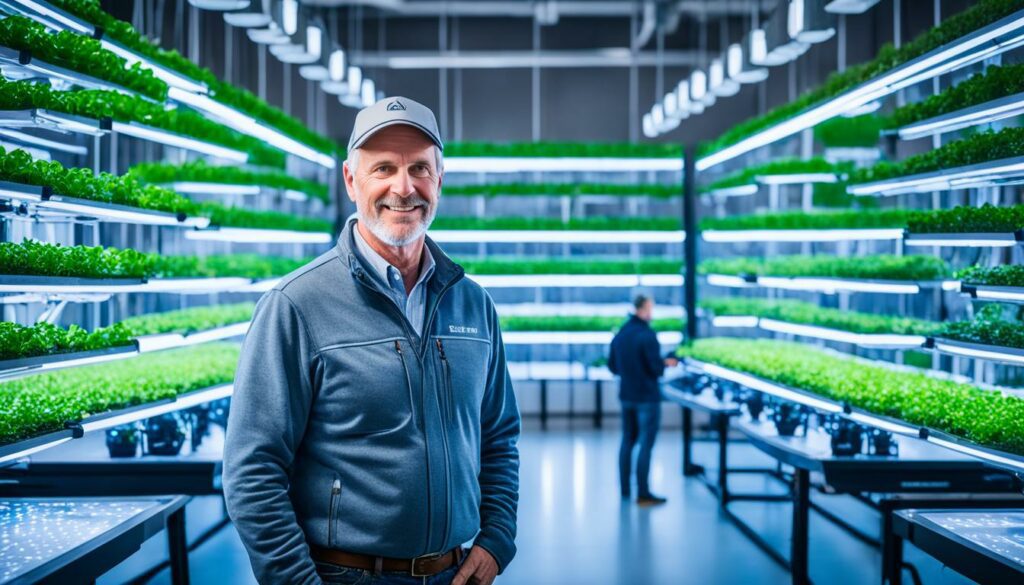
The market for smart farming was worth $9.4 billion in 2022. It is projected to grow a lot, reaching $24.09 billion by 2030. This shows how important computer vision in agriculture is becoming. It is used to watch over animals and fish. This makes sure they are well cared for and their homes are in good shape.
Advanced AI can now spot diseases in plants and estimate how much they will grow. It also helps keep farms safe. By using small computers and clever machines, these tasks are faster and more accurate. This is great for big farms, as it makes handling many fruits or vegetables easier and stops them from being wasted.
Not just plants, but animals also benefit a lot from smart farming. With fewer workers available, computer vision steps in to keep farms running well and food safe. This is seen in how efficiently chickens are raised and how fish are fed. AI and smart computer vision play a big part in these modern farming methods.
To sum it up, joining artificial intelligence with smart computer vision aids farming a great deal. It makes farming more efficient, keeps animals well, and promotes farming that takes care of the environment.
In the agritech world, crop management software is a key player. It leads the way in boosting productivity and sustainability. Since the 1980s, when GIS was first used, to the recent growth of cloud computing, it has made big leaps. These advances help in making precision agriculture even better.
Crop management software is very important. It gives farmers the tools they need to make their farms better. They can get exact advice on planting, watering, feeding, and keeping pests away. This means farms can grow more food in a way that’s kinder to the earth.
Being smart with data is changing farming for the better. By using crop management software, farmers can plan smarter. They know when to plant, how to use their resources, and when to harvest. This makes their farms run more smoothly. Plus, some software can even control watering systems on its own, saving farmers lots of time.
There are real stories that show how good crop management software is. Take California’s Central Valley, for example. It’s a big farming area. Here, using smart software not only grows more food but also uses less water. This change is better for the planet.
Besides, it’s easier now for farmers to keep an eye on their fields, thanks to apps and the cloud. This means farmers can work from anywhere. FarmERP is great for this. It offers tools that help farms do better. It’s safe to use and easy to understand.
“Approximately 9.8% of the world’s population, equivalent to 828 million people, were affected by hunger in 2021. Addressing this issue requires innovative agricultural solutions.”
| Criteria | Traditional Methods | Crop Management Software |
|---|---|---|
| Field Monitoring | Manual inspections | Automated with sensors and drones |
| Resource Allocation | Estimates | Data-driven decisions |
| Irrigation Systems | Fixed schedules | Precise control and automation |
| Yield Output | Variable | Optimised for higher productivity |
With precision agriculture, guessing in irrigation is a thing of the past. It uses AI and smart farming data for precise and real-time weather, soil, and crop health info. This leads to smart irrigation methods.
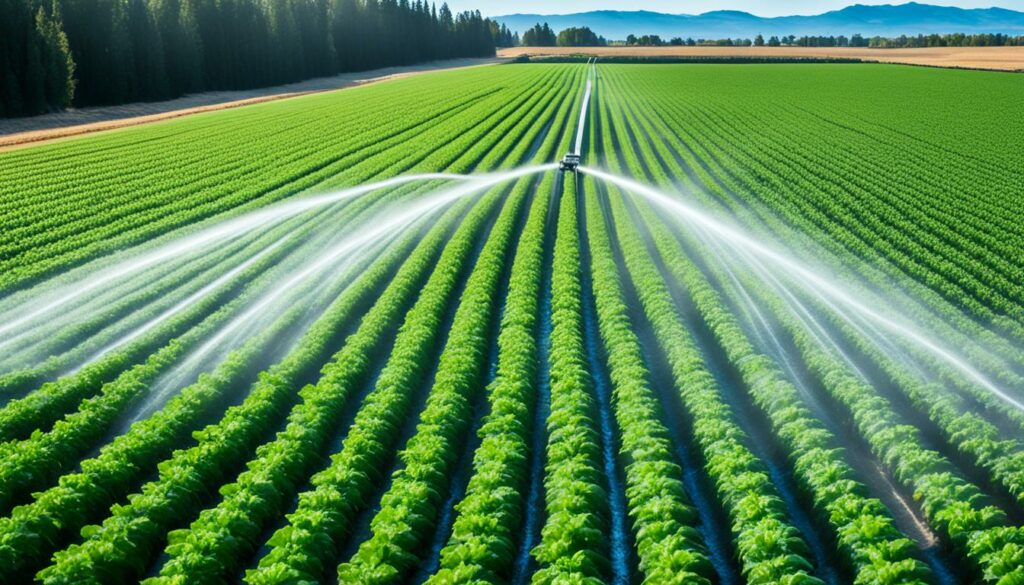
Precision agriculture’s tools help farmers use water better and grow more crops. It has increased crop production by 4% and cut water use by 4%. This saves resources and boosts output.
Real-Time Kinematic (RTK) and Global Positioning System (GPS) make detailed maps of irrigation. RTK lets farmers plant seeds and set up irrigation precisely. This helps use water efficiently and improve how irrigation works.
Investing in precision farming tools brings big benefits. For example, drones with RTK tech can check vast areas in less than 30 minutes. This saves time and gives detailed soil and crop data for better irrigation plans.
Geographic Information Systems (GIS) and Variable Rate Technology (VRT) are key for precise irrigation. GIS divides farms into segments, while VRT waters each area as needed. This ensures water is used well.
Advanced irrigation methods from precision farming help the environment. They reduce water use by 4%, leading to big savings. Drones, sensors with AI, and computer vision team up to manage resources better.
Precision agriculture makes farming smarter by giving farmers up-to-date info for better choices. This approach doesn’t just help grow more. It also helps farms last longer, using resources wisely for the best results.
| Aspect | Impact |
|---|---|
| Crop Production Increase | 4% |
| Reduction in Water Usage | 4% |
| Herbicide Use Reduction | 9% |
| Fossil Fuel Savings | 6% |
| Enhanced Fertilizer Efficiency | 7% |
Climate change affects agriculture with its unpredicted weather and environmental hurdles. My research highlights agricultural technology solutions as key in tackling these issues.
The use of precision agriculture analytics stands out. It predicts weather and helps farmers deal with its effects. This is crucial for keeping farm production steady amidst climate change.
Take satellite IoT tech; it has helped farmers gain nearly $90 more profit per acre. It allows for precise decisions based on data. This approach is better for the environment, using water, fertilisers, and fossil fuels more efficiently. It shows the power of precision agronomics.
Farmers using precision technology are moving towards sustainable and efficient farming. By using tools like GPS soil testing and VRT, they spend less on inputs while improving crop yield. This shift not only saves money but also boosts productivity.
IoT-based tools are revolutionising farming, offering detailed insights into crop health from afar. Systems that automatically water crops, decided by weather and soil sensors, show how tech meets sustainability goals. They make irrigation smarter and support eco-friendly farming.
More and more, farmers are turning to precision technology and agricultural tech to combat climate change’s effects. This adoption is key for a farming future that’s strong and sustainable.
In precision agriculture, many success stories show how farm tech is changing the game. These examples help us see the big change innovative technology is making in farming.
The Central Valley in California shows how powerful precision agriculture can be. With tech like telematics and GPS, farmers here are getting more from their land. They’re saving water and using resources smarter. This success proves that using tech in farming makes a real difference.
John Deere is a leading name in farming, pushing the boundaries with new tech. John Deere’s innovations go beyond machines to smart platforms and data analysis. These agricultural technology solutions are changing how farms work by boosting efficiency and harvests. They show that even the oldest farm businesses can grow using the latest tech.
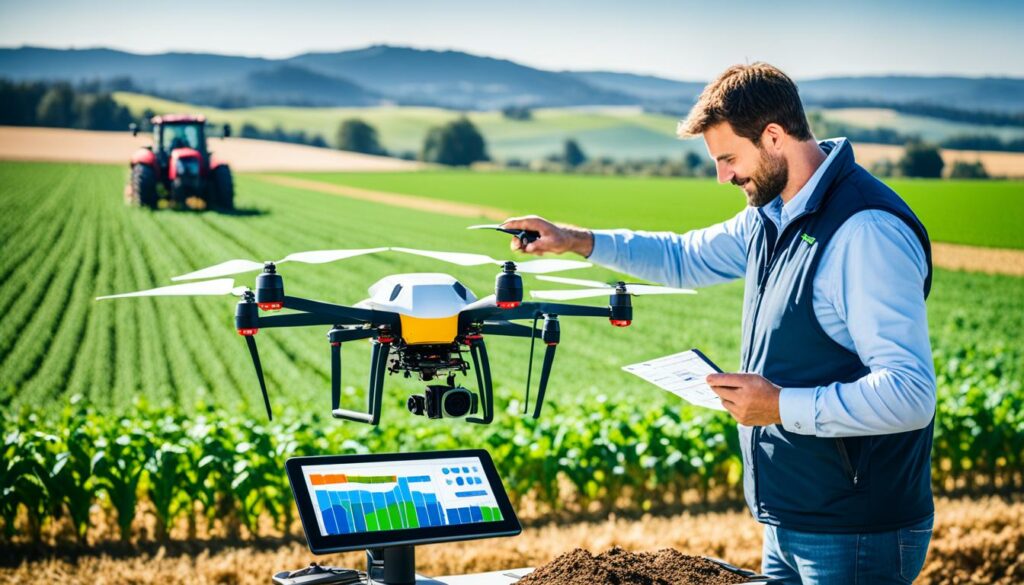
Digital agriculture faces many key challenges that require smart solutions. Access to diverse data and bringing different data types together is a big hurdle. Data from agriculture often comes in unique ways, making it hard to use together. This needs to change, so all data can work together smoothly. More data from sensors and tech means we need better ways to handle it. This is where AI and machine learning come in, helping to manage all the information better.
There are also issues with getting data in places with poor internet. However, there are solutions, such as edge computing. This lets farms process their data close by, without needing big online resources. But, getting this tech can be expensive, especially for smaller farms.
Integration issues arise when adding new tech to old machinery. Also, there aren’t enough experts who can help with combining data and making the most of technology.
Tools in digital farming are not always easy to use. They should be made simpler to encourage more farmers to use them. The aim is to make these solutions do more of the hard work. This way, farmers spend less time in the office.
Building strong relationships with farmers is crucial for the success of digital agriculture. It is vital to meet and talk in person, not just rely on the internet.
The precision agriculture market is set to grow, with a CAGR forecast of 10.7%. It will jump from $1.1 billion in 2023 to $2.9 billion by 2033. Much of this growth comes from using IoT in farming. IoT tools like sensors, drones, and GPS tech send valuable data on soil and crop conditions.This smart farming data includes soil moisture, temperature, humidity, and plant health updates in real-time.
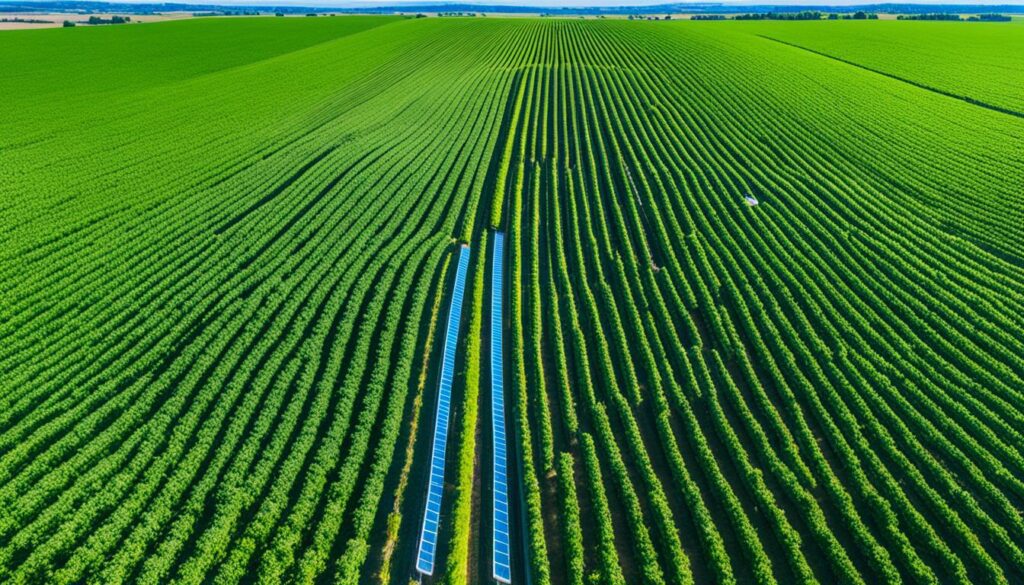
Technological solutions in agriculture use AI to analyse this data. They then suggest how to improve crop yields, spot diseases early, and better use resources. By acting on this advice, farmers can increase their crop production.This approach not only boosts crop yields but it also cuts down on resource waste. It helps the environment too, by making agriculture more sustainable.
Despite the benefits, there are still challenges. Small farmers might find the initial costs too high. There are also concerns about data safety, tech compatibility, and cyber threats. But these issues don’t take away from IoT’s potential in agriculture. It can make farming more efficient, eco-friendly, and resilient to climate change.
The numbers show the growth in agronomy funding. Over the past ten years, it has gone up by almost 80%. The smart agriculture market is worth about $4.6 billion. This market saw a CAGR of just under 12% from 2015 to 2020. The US is also expected to see more use of farming software, with over a 14% growth expected soon.
| Benefits | Details |
|---|---|
| Enhanced Crop Yields | Precision agriculture can significantly improve crop yields by optimizing resource inputs. |
| Resource Efficiency | Real-time data minimizes the use of water, fertilizer, and pesticides. |
| Sustainability | Reduces environmental impact through efficient resource usage. |
| Cost Reductions | Minimizes input costs and operational expenses. |
| Early Detection of Issues | IoT sensors and imaging technologies enable early detection of pests and diseases. |
Predictive modelling is key in modern farming, providing many benefits. It covers everything from planting to harvest. This tech uses smart algorithms to predict how crops will turn out. It looks at lots of data like biology, weather, water, and money matters.
One big benefit is guessing when crop diseases might strike. By looking at past and current farm info, models can predict outbreaks. This early warning helps stop crop damage. It makes sure treatments like pesticides work when they should.
Predictive tech is also great for fighting pests. It looks at bug behaviours and links them to weather and crop stages. This helps farmers make smarter pest control choices. They can use fewer chemicals. This helps crops, the earth, and saves resources.
Adding tech like weather stations and genetics does even more. It makes crop predictions better, helps fight against the weather, and uses land better. Yet, we need to handle issues like data quality and sharing. We also must integrate tech well to truly benefit from predictive models in farming.
| Benefits | Impact on Agriculture |
|---|---|
| Increased yield predictions by 25% | Improved choices and care for crops boost how much we farm. |
| Reduced resource usage by 20% | Making better use of land and inputs makes farming more efficient. |
| Decreased environmental impact by 25% | Decisions based on data reduce harm to the environment. |
In summary, predictive modelling changes farming for the better. It keeps farming strong and moving towards being more eco-friendly and able to face challenges.
The agriculture analytics market is growing fast, powered by big agritech companies and new tech. It’s expected to change how farming works all over the world with an annual growth rate of 14.4% between 2021 and 2026. This growth is crucial as we expect the world’s population to reach 9.7 billion by 2050. There’s a bigger need for farming tech that’s both efficient and good for the environment.
Key movers in this area include IBM, supporting start-ups in farming analytics with the help of data centres. This boosts the development of smart, data-focused solutions. Deere & Company is also making big moves by blending cutting-edge analytics and IoT tech in its products. Not to forget AgroTools, using the Google Cloud to oversee farming lands through satellite images over an area as big as Denmark, Italy, and France combined. This shows how powerful precision agriculture analytics can be.
Now, North America leads the agriculture analytics market, showing its critical position. Yet, the Asia Pacific region is becoming the market’s fastest-growing part. This advance is due to new technologies and a rise in spending in this sector. This is crucial with climate change affecting how we produce food globally. The COVID-19 pandemic has highlighted the importance of solid, data-focused tools like AI and machine learning in handling the challenges in farming.
Key players in a competitive field, including Trimble Inc., Bayer AG, and Ageagle Aerial Systems Inc, are constantly improving their products. They work closely with partners to grow their client base and boost what their products can do. For example, Ag-Analytics launched a UAV service for crop growers that they can access from anywhere. Growers Holdings, Inc., on the other hand, joined forces with SAS Institute to provide insights that help in managing farms better.
By banking on precise agriculture analytics, these big agritech players are crafting a future that’s more efficient and better for the planet. They aim to meet the ever-growing demand for food in a sustainable way. The growth prospects for the agriculture analytics market look good as it moves towards more sophisticated and eco-friendly farming practices.
Precision agriculture analytics use high-tech tools to boost farming. It aims to increase crop yields while saving resources. These tools include sensors, drones, and satellites. They collect data for smarter decisions on planting, watering, and fertilising.
Smart farming data brings real-time insights to farmers. It looks at things like soil moisture and weather to help plants grow better. This means the farmers can use less resources but still get great crops.
Machine learning makes farming smarter by watching crops and spotting diseases early. It uses data from sensors, drones, and satellites. This data gives farmers quick updates. So, they can improve crop health right away.
Field monitoring uses sensors and data from far away. It checks on plants and the land all the time. This information guides choices on how to best use resources and protect crops.
AI and computer vision look at pictures from above and data from the ground. They help with watering, feeding, and finding problems early. These methods boost how much we grow crops while protecting the environment.
Yes, in Central Valley, California, precision farming grew more crops but less water was needed. John Deere’s smart machines are also a big hit. They show how using technology well can change farming for the better worldwide.
Digital farming deals with not everyone being able to use technology, privacy, and sharing data. Solving these problems needs smart planning and learning. This makes sure agriculture technology is used well by all.
IoT devices give non-stop updates on the farm. Farmers can make better choices on everything from where to water to how to grow plants. This technology is essential for making farms work better and produce more.
Predictive models can forecast diseases and pests. They use past and current data to give farmers tips ahead of time. These early alerts help crops stay healthy, saving the farmers from big losses.
The market has big companies and small tech businesses alike. Taranis, John Deere, and PrecisionHawk stand out with their innovative solutions. They aim to make farming more productive and eco-friendly.